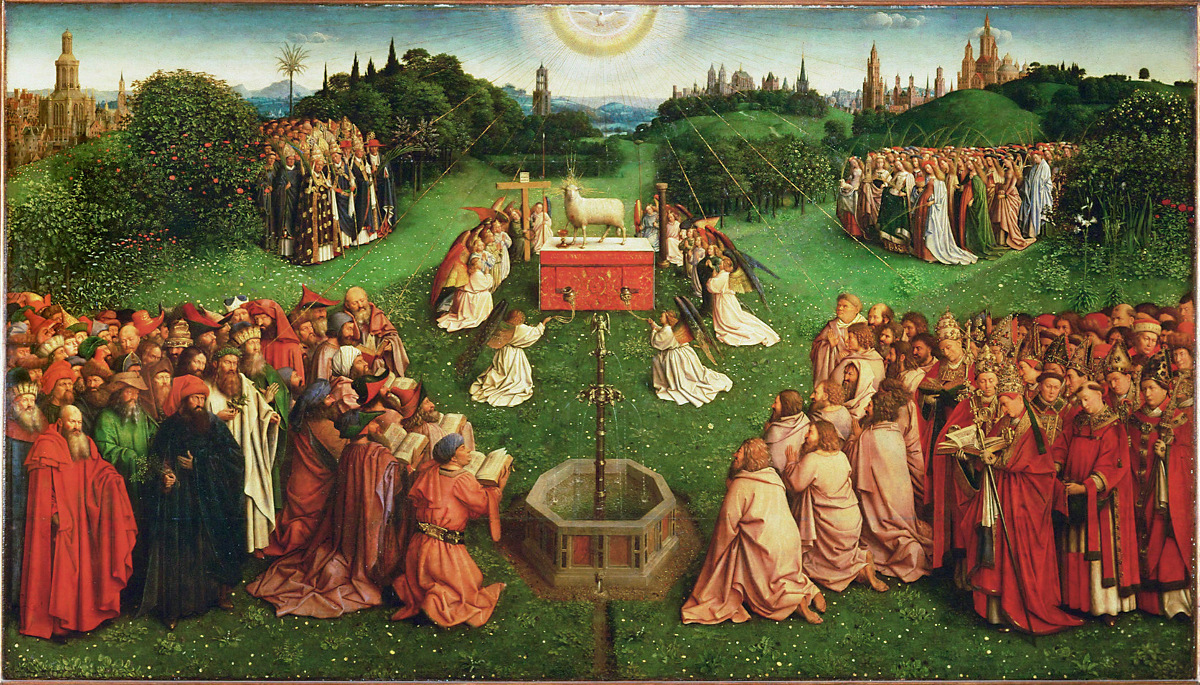The Lamb's Supper: The Bible and the Mass
Lesson Four: Fulfilled in Your Hearing: The Liturgy of the Word

Lesson Objectives
- To understand Scripture as the living Word of God.
- To understand the place of Scripture at the center of the liturgy.
- To see Scripture as an encounter with Christ, the living Word of God.
- To see how the Liturgy of the Word prepares us for the Liturgy of the Eucharist.
II. God-Breathed
A. No Ordinary Book
That's why before the priest reads the Gospel, he kisses the book; and before we listen, we trace the sign of the cross on our foreheads, lips and hearts, giving thanks and glory to God.
These are not empty gestures or rituals. We do these things for one crucial reason: because we are receiving Scripture as the first Christians received it — “not as a human word, but as it truly is: the Word of God” (see 1 Thessalonians 2:13).
And that's why the Scriptures always have an honored place in our churches.
In many churches, the Book of the Gospels is elaborately bound, carried in processions, and placed centrally on the altar for the liturgy. It is the central object of the Liturgy of the Word, and we treat it with the respect due the Word of God.
Our respect for the Scriptures is nothing new. We can see the same profound respect in the New Testament writers.
When we see the word "Scriptures" in the New Testament, of course, it almost always refers to what we today call the Old Testament (see, for example, John 5:39 and Romans 1:2).
The Jews of Jesus' time often referred to the Scriptures as "the Law and the prophets" (see Matthew 5:17) – by which they meant all that we understand as the Old Testament today.
Jesus and His disciples, like all good Israelites of their time, understood that these were no ordinary books or writings. The Scriptures were "oracles of God" (see Romans 3:2) or "prophecies" (see 2 Peter 1:19-20) - not in the sense of predicting the future, but in the sense of being messages from God.
"All Scripture is inspired by God," Paul writes (see 2 Timothy 3:16). The Greek word we translate "inspired" literally means God-breathed. And that's a good way to think about the divine inspiration of Scripture.
As God fashioned Adam out of the clay of the earth and blew the breath of life into him (see Genesis 2:7), and as the Holy Spirit overshadowed Mary (see Luke 1:35), God breathes His Spirit into the words of Scripture, filling them with divine meaning and life-giving power.
B. Inspired Oracles of God
That's why New Testament writers sometimes introduce quotes from the Old Testament with "as the Holy Spirit says" (see Hebrews 3:7; Acts 1:16). Scripture, the Apostle Peter said, is written by "human beings moved by the Holy Spirit [who] spoke under the influence of God" (see 2 Peter 1:21).
When Peter and the other New Testament authors spoke and wrote, they were being moved by the Holy Spirit, and they were writing under the influence of God.
Paul "wrote....according to the wisdom given to him" by the Holy Spirit, Peter said (see 2 Peter 3:15-16). Paul himself said: "We speak...not with words taught by human wisdom, but with words taught by the Spirit" (see 1 Corinthians 2:13).
And many of the writings we have from the New Testament were explicitly written to be read in the context of the Eucharistic celebration (see, for example, 1 Corinthians 1:2; 1 Timothy 1:1; Revelation 1:11; Colossians 4:16, 1 Thessalonians 5:27).
Other Lessons
- Lesson One: A Biblical Introduction to the Mass
- 1. To understand basic Catholic beliefs about the relationship between the Bible and the Liturgy.
- To understand the biblical basis for the Mass.
- To understand how in the Mass, the written text of the Bible becomes Living Word.
- Lesson Two: Given for You - The Old Testament Story of Sacrifice
- To understand the biblical background to the Penitential Rite and the Gloria in the Mass.
- To understand how God is worshipped in the Old Testament.
- To understand the biblical notion of sacrifice as it is presented in the Old Testament.
- Lesson Three: One Sacrifice for All Time
- To understand the death of Jesus Christ on the cross as a sacrifice.
- To see the parallels between the Old Testament sacrifices and the sacrifice of Christ on the cross.
- To understand how that sacrifice is re-presented to us in the Mass.
- Lesson Five: Heaven On Earth: The Liturgy of the Eucharist
- To understand the deep biblical foundations for the Liturgy of the Eucharist.
- To see how the Book of Revelation describes the liturgy of heaven.
- To understand how the Mass we celebrate on earth is a participation in the liturgy of heaven.
- Lesson Six: Memory and Presence: Communion as the Coming of Christ
- To understand the deep biblical foundations of Jesus’ command that the Eucharist be celebrated “in memory of Me.”
- To see how Scripture portrays Jesus as the Passover Lamb and how that portrayal is reflected in the Mass.
- To understand the Eucharist as parousia, the “coming” of Christ, and as the “daily bread” we pray for in the Our Father.


